
A shrub or bush is a small-to-medium-sized perennial woody plant. Unlike herbaceous plants, shrubs have persistent woody stems above the ground. Shrubs can be either deciduous or evergreen. They are distinguished from trees by their multiple stems and shorter height, less than 6–10 m (20–33 ft) tall. Small shrubs, less than 2 m (6.6 ft) tall are sometimes termed as subshrubs. Many botanical groups have species that are shrubs, and others that are trees and herbaceous plants instead.

Daphne is a genus of between 70 and 95 species of deciduous and evergreen shrubs in the family Thymelaeaceae, native to Asia, Europe and north Africa. They are noted for their scented flowers and often brightly coloured berries. Two species are used to make paper. Many species are grown in gardens as ornamental plants; the smaller species are often used in rock gardens. All parts of daphnes are poisonous, especially the berries.

Daphne mezereum, commonly known as mezereum, mezereon, February daphne, spurge laurel or spurge olive, is a species of Daphne in the flowering plant family Thymelaeaceae, native to most of Europe and Western Asia, north to northern Scandinavia and Russia. In southern Europe it is confined to medium to higher elevations and in the subalpine vegetation zone, but descends to near sea level in northern Europe. It is generally confined to soils derived from limestone.

Daphne bholua, the Nepalese paper plant, is a species of flowering shrub in the genus Daphne of the family Thymelaeaceae. It grows at altitudes of 1,700–3,500 m (5,577–11,483 ft) in the Himalayas and neighbouring mountain ranges, from Nepal to southern China. At lower altitudes it is found as an evergreen in thickets and forest margins; at higher altitudes, it is deciduous and is usually found in pastures and grassy glades. It usually reaches a height of about 2.5 m, though some specimens reach 4 m (13 ft) or more.
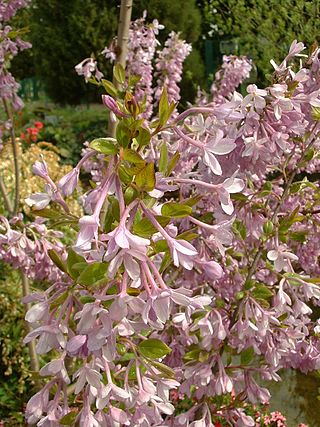
Daphne genkwa is a deciduous shrub and one of the 50 fundamental herbs used in traditional Chinese medicine, where it has the name yuán huā.
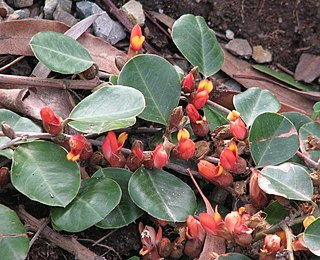
A prostrate shrub is a woody plant, most of the branches of which lie upon or just above the ground, rather than being held erect as are the branches of most trees and shrubs.

Pultenaea daphnoides, commonly known as large-leaf bush-pea or large-leaf bitter-pea, is a species of flowering plant in the family Fabaceae and is endemic to south-eastern Australia. It is an erect shrub with egg-shaped to wedge-shaped leaves with a pointed tip, and dense clusters of bright yellow and red flowers.

Pimelea octophylla, commonly known as woolly riceflower or downy riceflower, is a species of flowering plant in the family Thymelaeaceae and is endemic to south-eastern continental Australia. It is an erect shrub with densely hairy young stems, narrowly elliptic leaves and heads of 22 to 45 densely hairy, cream-coloured to pale yellow flowers surrounded by 6 to 12 leaf-like involucral bracts.
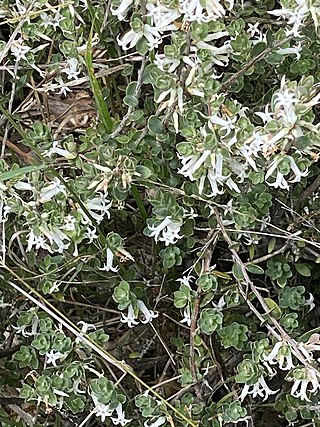
Brachyloma daphnoides, commonly known as daphne heath, is a flowering plant in the family Ericaceae. It is a small upright shrub with dull grey-green leaves and white tubular flowers.

Lokta paper, also known as Nepali kagaj or Nepali paper, is a wildcrafted, handmade artisan paper indigenous to Nepal. It is made from the bark of two of the species of the shrub Daphne. The paper was used historically in Nepal for religious scriptures and government documents. In modern day, the paper is used to make notebooks, religious scriptures, arts, painting canvas and for some of the government documents.

Daphne gnidium is a poisonous evergreen shrub from the Mediterranean region with narrow, dense dark-green foliage and white fragrant flowers.

Philotheca myoporoides, commonly known as long-leaf wax flower, is a species of flowering plant in the family Rutaceae and is endemic to south-eastern Australia. It is a shrub with sessile, oblong to egg-shaped, glandular-warty leaves and white to pink flowers arranged singly in leaf axils. Prior to 1998 it was known as Eriostemon myoporoides.

Daphne sericea is a shrubby species of flowering plant in the genus Daphne with purple flowers. It was described by Martin Vahl. Daphne collina has been treated as a separate species, but is considered to be a cultivar or group of cultivars of D. sericea.
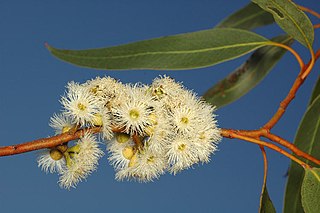
Eucalyptus petraea, commonly known as granite rock box, is a species of mallee or a small tree that is endemic to Western Australia. It has thin, ribbony or flaky to fibrous bark on the lower trunk, smooth greyish above, lance-shaped adult leaves, flower buds usually in groups of seven, creamy white flowers and conical fruit.
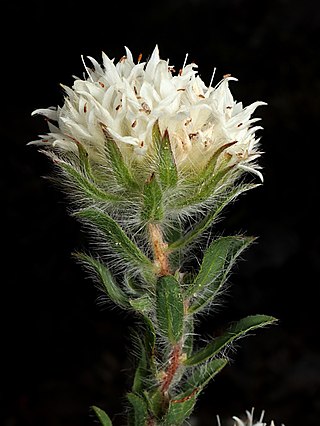
Pimelea imbricata is a species of flowering plant in the family Thymelaeaceae and is native to the southwest of Western Australia and south-eastern South Australia. It is a shrub with narrowly elliptic leaves and erect, compact clusters of white or pink flowers surrounded by 10 to 22 green or red to purple involucral bracts.

Daphne papyracea is a shrub, of the family Thymelaeaceae. It is evergreen, and is found across Asia, from Pakistan through central Nepal to China. Generally it is found at elevations from 700 to 3,100 metres. Daphne laciniata from Yunnan has been treated as a separate species or as part of D. papyracea.

Daphne alpina is a shrub, of the family Thymelaeaceae. It is deciduous, and is found in southern and central Europe.
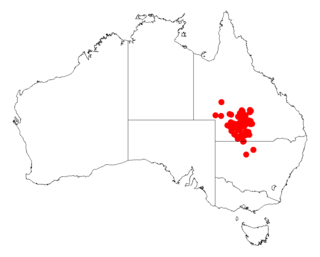
Acacia petraea, commonly known as lancewood, is a shrub or tree belonging to the genus Acacia and the subgenus Juliflorae that is native to north eastern Australia.
Philotheca myoporoides subsp. petraea is a subspecies of flowering plant in the family Rutaceae and is endemic to a small area in Victoria, Australia. It is an erect shrub with leathery, egg-shaped leaves with the narrower end towards the base, and white flowers arranged singly or in groups of up to four in leaf axils.

Prostanthera petraea is a species of flowering plant in the family Lamiaceae and is endemic to a restricted area near the Queensland–New South Wales border. It is a large shrub to small tree with ridged, glandular branches, egg-shaped leaves and white flowers usually without markings.



















